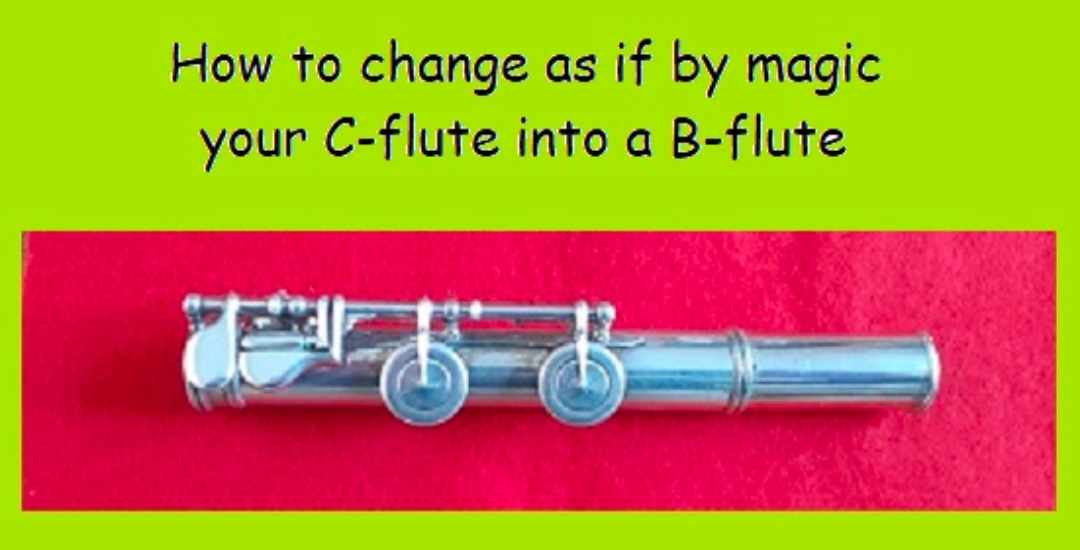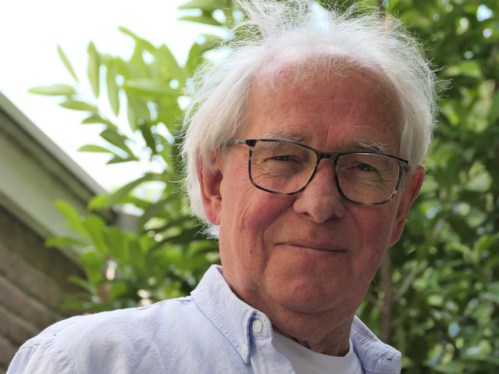
by Jan Karman
How it started
One of my most favorite melodies of Bach, that I play on my flute, is his Alto Aria from Cantate BWV 170, “Vergnügte Ruh, beliebte Seelenlust”.
Transcribed for his Oboe Concerto, it is written in D major, with this passage, going down to B.

How would I ever be able to play this on my flute, i.e. one with just a C-foot?
Spending € 1.500 and buying a B-foot?
I was rather thinking of lengthening the air-column of my flute by about 45mm, in such way that, when played the C as the lowest tone, it would give a B in stead of a C.
Fortunately, there’s no low C in that melody, so I could interchange harmlessly the C for a B. (However in the Prelude there is one, so this only holds for the Air).
But we’re talking just about the principle here. And, by the way, there exists a bunch of pieces having that B without the C showing up. So, it would pay off.
The process
How to find a little piece of tube that would fit exactly in the lower joint of my flute?
NB! It should fit seamlessly, i.e. light and, at any rate, air tight! Otherwise there would be annoying side noises.
As said before, I can’t afford a B-foot for € 1.500.
An alternative could be of letting it forged by a silver or goldsmith: € 425!
Then, I found in our kitchen drawer some utensils that had a hilt of about the intended diameter – stainless steel, that is. Measuring with my micro caliper I learned that those hilts vary between 18.75 and 19.25 mm, depending on the make.
So, I walked for days in kitchen shops with my caliper to find something useful, and finally found a cream whipper in a recycling shop for 50 cents.
Cutting the hilt into two pieces I finally saved this one:
It’s 50mm long and it has an exact diameter of 18.95mm.

When placed in the tube of my flute, the most surprising thing was that it worked! I could now play the B!
The Material
While working flawlessly, for that matter, I didn’t like the material that much: stainless steel on a 925-silver flute …hmm – found it sort of blasfemic and I wanted it in silver.
So I decided to make a prototype myself.
First used a 0.2mm plate of bronze, 50 x 59.5mm. Ample, because I could file it onto an exact fit after the rounding and if succeeded from a 0.3mm plate. I had in mind, if everything went ok, to finally make it out of a 925-silver plate of 0.3mm.
While proceeding one will encounter needs that you don’t have at hand.
For the rounding, one will need a series of jigs, with Ø say 10mm thru e.g. 25mm, in order to be able to, starting with the biggest one, consecutively getting smaller and smaller until you have the desired 18.95mm.
For easy handling the rounded plates one can use pieces of bamboo, the holes of which are pretty well-centered, so you can also use them on your electric drill, for e.g. polishing.
Then comes the soldering: a skill I don’t have. No problem: just like playing the flute – learning & practizing!
Then, an other surprise is emerging: one can solder bronze with a soldering-iron, the so called soft soldering, but with silver you can’t. Silver needs a flame. “No, thanks!”
Finishing Touch
Finally having the exact fit of the tube I went to a goldsmith for the soldering and polishing, and if everything would be satisfying, a little decorative ring at the edge.
Done!
The final product and its name
In analogy of the name for the entire foot-joint, B-foot, I baptized the little tube: B-Toe.
… and a picture

As you may see on the picture, you can easily put on and take off this wonderful device, even during a few measures of rest.

Jan Karman
jkarman@planet.nl | LinkedIn | Twitter
Born in 1937 in The Netherlands, music came to me very naturally: there was an abundance of music making and singing in my family. I had been an organist in the local church, while not before my 17th I took formal lessons in playing the organ, the piano and theory of harmony under supervision of a very strict teacher, during several years.
Later I studied and played the flute for many years, with Edo Wilod Versprille and Henri P. Augusteijn, learning the old German and Italian masters, but also such composers as Janacek, Hindemith, Genzmer.
I performed in some local recitals playing the Bach-sonata’s and the early modern French composers as Fauré, Koechlin, Ibert, Roussel and also at other occasions such as convents and meetings of different kind, in order to add lustre.
More recently studied three years piano with Rien Balkenende. On my request I studied the works of Federico Mompou (Canciones y Danzas) and Gabriel Fauré (Nocturnes).
Always having done improvisation on my instruments I occasionally did some compositional work, but since early 2008 seriously so, and on a continuous basis, among others Élégie for flute solo, Pastorale for piccolo, flute & alto flute, A Piccolo’s Delight (Rhapsodie of Golden Oldies) and an 80 fugues on the melodies of the Genevan Psalter for Church Organ.
Main influence came from the Flemish Renaissancists, Joh. Seb. Bach and his predecessors like Joh. Christoff Bach (44 Choräle zum Präambulieren), and from several 20th century French composers, as well as the Belgian organist/composer Flor Peeters.
Having made a professional career in the field of actuarial science and information technology, as a composer I’m an autodidact.









Geniale!
I will try do it by bamboo I have in my garden! I will add also a hole for the C with a long key…
Thanks, Roberto!
Wishing you success!
Una soluzione semplice ed efficace.
Bravo Jan e grazie per il tuo contributo!
Thank you, Onorio!
Thanks to Yulia as well!
You both are doing a great job!
Thank you Jan! And what a brilliant and elegant solution you proposed! Great witty article!
Thank you, Yulia!
Very honored!
You are an amazing problem solver and your music is beautiful, c
Dankjewel, Lottie!
Zeer vereerd!
Ingenious and with such a great result!?
Thank you, Marijke!
So where can a B toe be purchased?
I think Jan’s point was that anyone can do it at home, if it is really needed and willing to save $$$.
Hi Kathy!
It can not be purchased anywhere, because it can’t be made ‘industrially’. The boring of the tube depends on the make, and many flutes in that class are handmade.
So, try to find a hilt of some kitchenware that fits.
In case you have a micro caliper …
Idea super geniale, in orchestra ho provato con un pezzo di carta che ha prodotto il Si.
Il problema si presenta quando si deve suonare Si e Do , cosa consiglia?
I mentioned it in my article. Actually, there no solution for that, except when it occurs play c2 (one octave higher).